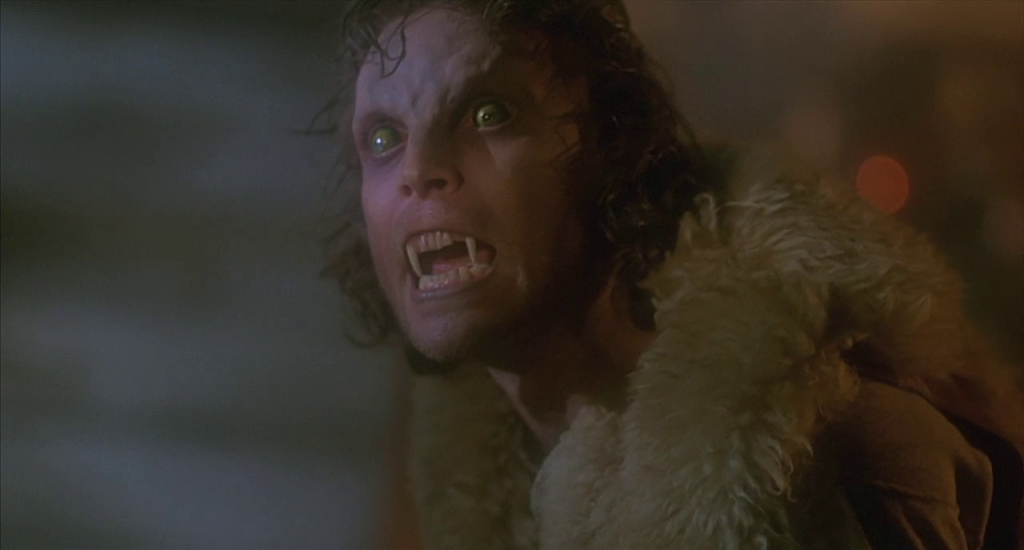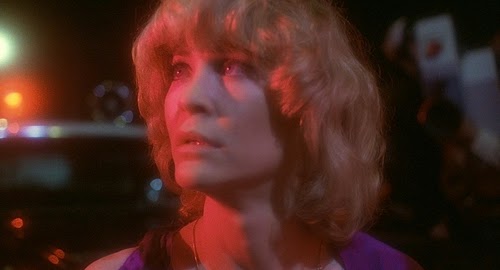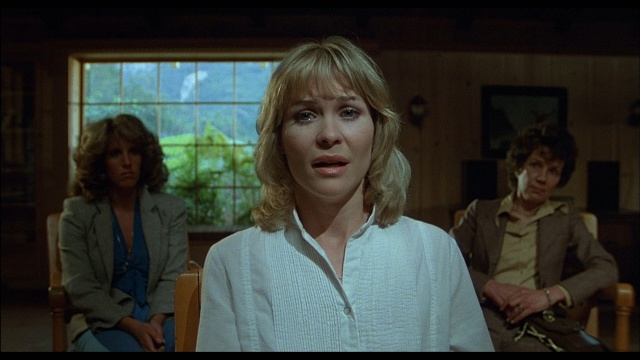
This January, in support of the Toronto Rape Crisis Centre / Multicultural Women Against Rape, friends and family have raised over $1,500 (which, when matched by my employer, totals $3,000). As a result, I now have to watch and write about thirty-one horror movies: one each night. Any donors who contributed over $30 were given the option to choose one of the horror movies I must subject myself to. After each viewing, I will write some things about said movies on this website. Be forewarned that all such write-ups will contain spoilers, and many of them will refer to unpleasant and potentially triggering situations. Today’s film is the Corey Haim / Gary Busey werewolf joint, Silver Bullet (1985), directed by Daniel Attias, who worked almost entirely in TV after this film. This film was not selected by any donors; rather it was an attempt to throw the werewolf genre a bone (get it?).
What happens:
Trigger warnings: Suicide.
Stephen King’s Silver Bullet (as that’s how the movie is billed) opens on a full moon. Set in the small town of Tarker’s Mills in 1976, the story chronicles a period when our teen narrator, Janey Coslaw (Anne of Green Gables herself, Megan Follows), tells us the town lived in terror. After the opening scene, viewers quickly realize why. Train worker, Ernie works late (and seemingly drunk on Rheingold beer). As he activates a railway switch, something unseen stalks him, Michael-Myers-like, from the bushes. Ernie just has time to see a large, claw-like footprint in the ground before his head is cut clean off by a werewolf.
When townspeople find Ernie’s severed head the next morning, no one suspects foul play: Ernie was known as a chronic drunk, and where his head and body fell make it appear as if he passed out with his neck upon the train track. Janey, in her voice-over, introduces us to her idyllic small town, where bake sales happen almost every weekend, and everyone in town attends church. Pillars of the community, Sheriff Joe Haller (Terry O’Quinn) and Reverend Lowe (Everett McGill) make some speeches at a spring fair, while Janey goes in search of her pesky younger brother, Marty. But before she finds him, she finds a garter snake hanging from a tree branch (yikes!). The snake prank was orchestrated by local pest Brady Kincaid (Joe Wright) and his friend / Janey’s brother, Marty Coslaw (Corey Haim). Marty is paralyzed from the waist down, and uses a wheelchair dubbed “the silver bullet” to get around. Backing away from the snake, Jenny falls into a mud puddle and ruins her nice clothes.
Janey runs away from Marty and Brady crying, and accidentally stumbles upon a domestic dispute: Stella Randolph (Wendy Walker) is pleading with her boyfriend, who refuses to admit the unborn child she’s carrying is his. Janey scurries back to her family. On their ride back home, the Coslaw parents (Robin Groves and Leon Russom) try to get their kids to make up, but Janey isn’t having it; she feels her parents favour Marty: “You always take his side because he’s crippled!” To irritate Marty, Janey tells him his favourite relative, Uncle Red, is an alcoholic who just got divorced for the third time (!). That evening, Marty, feeling shame over his stupid serpent-based prank, wheels into Janey’s room and leaves a pile of money on her nightstand so that she can buy replacement pantyhose for her now-mud-stained ones. Janey, who appreciates the gesture, gives him most of the money back, saying she’ll just buy L’Eggs.
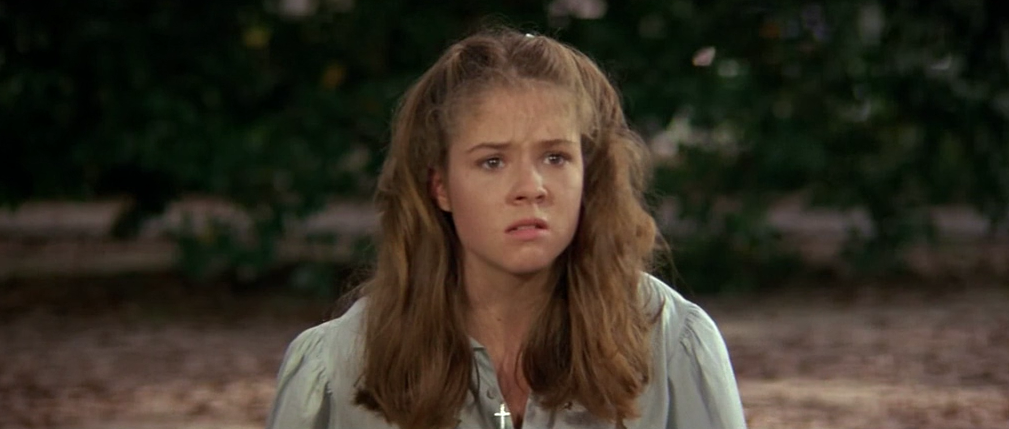
Across town at Stella Randolph’s house, her mother is running scales on the electric organ. Stella herself is upstairs, about to swallow a plate full of sleeping pills. “Suicides go to hell,” she muses, “especially if pregnant.” However, Stella never has the opportunity if that Catholic superstition is true, as a werewolf smashes through her bedroom window and begins to shred her up like pulled pork. (Gross!) Mother, hearing the commotion, grabs a pistol and moves to the bedroom, but she’s too late: Stella has been murdered and the killer has absconded before she arrives.
At the local watering hole, the townsfolk are riled up about Stella’s murder. Andy Fairton (Bill Smitrovich) thinks Sheriff Haller is incompetent, and many of the bar patrons agree. (Considering Stella was killed earlier that night, it’s unclear (a) how the entire bar knows about it, and (b) what they think the Sheriff should have accomplished by now.) The next day, Marty accompanies his (maybe) girlfriend Tammy Sturmfuller (Heather Simmons) home and they pass the crime scene at the Randolph’s. Once they arrive at the Sturmfuller residence, Tammy mentions she heard weird growling noises from their back shed the other night. Her prize of a dad, Milt (James A. Baffico), already drunk mid-afternoon, shouts at Tammy to come inside, just before grumbling to himself that people in wheelchairs should all be electrocuted (!).
That night, the Coslaws get a visit from Uncle Red (Gary Busey), who plays poker with Marty and tells him ribald jokes. Mrs. Coslaw is exhausted by her brother, who she feels shows up (like most uncles) to tell jokes and have fun, but is never there to do the heavy lifting. When Marty goes to bed, she warns Red she doesn’t want him drinking around Marty. She worries that Marty will turn to drinking later in life, given the difficulties of his paralysis, but Red argues Marty doesn’t have any limitations.

Back at the Sturmfullers’, Milt’s night of watching professional wrestling is interrupted by a ruckus in his shed. He takes his shotgun and goes to investigate who’s messing with his ceramic pots. The pots have all been smashed to bits, but there’s no sign of an intruder otherwise. That’s because the werewolf has hidden under the shed’s floorboards. He pops up, dragging Milt down below the shed and impaling him on a splintered 2×4 as he does.
Dread stalks the town. The Mayor demands results from Sheriff Haller. Shotgun sales are up. Andy continues to trash talk the Sheriff around town. Brady and Marty spend a very wholesome afternoon flying kites. Marty uses his massive upper-body strength to climb a tree that’s snagged his kite. Janey arrives in the park to inform him he’s late for dinner, so he hops down from the tree and the two leave Brady to continue flying his kite, though Marty seems concerned to leave his friend alone. He was right to be concerned: that night, Herb Kincaid (Kent Broadhurst) walks into the bar looking for his missing son, Brady.
Sheriff Haller finds a bloody kite and – in a nearby gazebo – the body of Brady Kincaid. Herb arrives at the park and the police aren’t able to restrain him before he gets a close look at his son and lets out an anguished cry. A funeral for the boy follows, with Reverend Lowe offering comforting words to the entire town. Uncle Red drives Marty home from the funeral. Marty wonders aloud if the killer isn’t a person; what if it’s a monster, like a werewolf? Red just laughs and assures his nephew he’s just a run-of-the-mill serial killer.
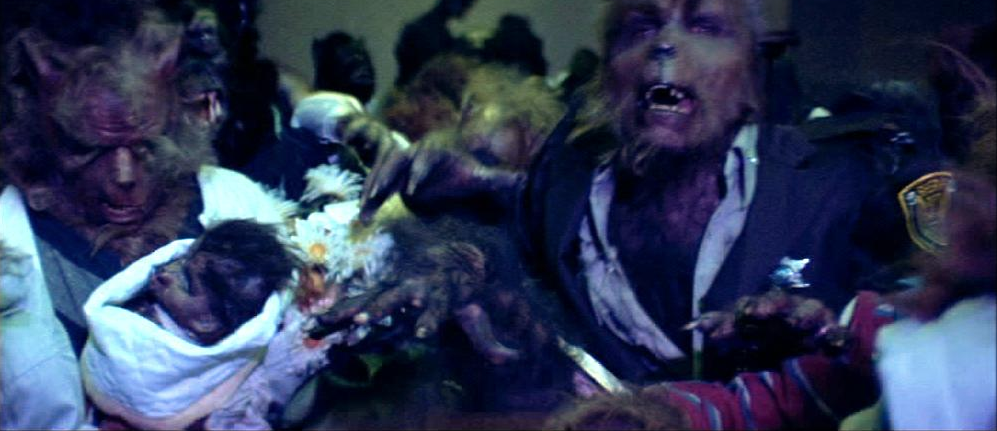
Andy, however, is not content to laugh. Instead, he rustles up a camo-styled militia at the local bar. Sheriff Haller gets wind of this and tries to break up the posse, not being too keen on the notion of “private justice.” But then Herb Kincaid arrives and raves about how his son was torn to pieces. He likes the idea of “private justice.” So, it’s on: the men and women race to their pick-up trucks. The Reverend arrives at the bar and tries to prevent them from doing something foolish, but his protests go unheeded. They dive headlong into the local forest, with guns, flash lights, hounds, and – in the case of one overly confident soul – a baseball bat.
One man is soon painfully caught by a bear trap. Andy takes a small squad and forms a “skirmish line” (whatever that is) to enter an area of dense fog. But they find out too late that the werewolf has been hiding under the fog. The monster drags one man under, tears off half of another’s face. Mr. Knopfler attacks with his baseball bat, but the werewolf soon turns it against him. The next day, the funeral hosts three funerals in one.
Reverend Lowe again tries to provide some solace to his scared and angry flock. But the town residents are especially agitated. They begin to snarl and slowly transform into werewolves – all of them! Even his organ player! Lightning crashes outside the church and the Reverend awakes with a start: it was just a nightmare.
The killings are affecting social activities in Tarker’s Mills. The fireworks display has been cancelled, much to Marty’s chagrin, but at least Uncle Red is visiting for a family barbecue. He shows Marty something he’s been working on: the Silver Bullet, a souped-up wheelchair scooter that looks like a Rascal crossed with a Rat Fink illustration. “It’s an ass-kicker, ain’t it?” he asks, rhetorically, I assume. Marty gives the new chair a spin on the country road and it really rips, passing even cars. When he returns, Red warns him not to tell his mother how fast it goes.

Following a very pleasant barbecue, Uncle Red secretly passes Marty one additional gift: a bag full of contraband fireworks. He asks Marty to promise to only use them close to the house, but literally that night, Marty breaks his promise, driving the Silver Bullet to a wooden bridge somewhere in the woods to light the fireworks far from the prying eyes of his parents. Of course, all these Roman candles and the like attract the werewolf, who finds Marty blissfully being a pyro in the middle of nowhere.
The werewolf approaches and Marty frantically lights a large bottle rocket, managing to fire it directly into the monster’s eye. The werewolf howls in pain at the gory injury. While it recovers, Marty races back and arrives safely at home, though extremely scared. Uncle Red is woken early the next morning by a phone call. Marty tells him all about his werewolf encounter, and Uncle Red doesn’t believe a word. Luckily, his sister Janey has a more open mind. Seeing Marty withdrawn, she asks what’s the matter and hears his werewolf anecdote. She realizes how strongly her brother believes it, and constructs a plan.
Janey regularly collects bottles and cans to generate money for the church. So she goes door-to-door, asking for bottles and paying close attention to how many eyes everyone has. (If the werewolf was shot in the eye, the human version should, theoretically, have some sort of eye injury.) Janey goes above and beyond the call of duty, even pulling hot towels off men’s faces at the barber shop. But no one in town seems to be a missing eye. She brings the bottles and cans to the church garage for storage, which is when she spies Mr. Knopfler’s bat (“The Peace Maker”) among the cans. When she turns to leave, the Reverend – who has a fresh bandage over his left eye – asks if everything is all right. Trembling, Janey leaves as soon as possible. (Her poker face could really use some work.)

Marty and Janey begin to mail ransom-like letters to the Reverend, saying they know who he is, which – from the looks of the Reverend’s face – doesn’t make him overly happy. When Uncle Red learns about their letter campaign, he insists they stop. Red agrees to stake out the church with the kids, but they don’t see anything untoward. But the Reverend later stalks Marty at a baseball game, and follows the Silver Bullet in his powder-blue Malibu. When the two hit a stretch of vacant country road, the Reverend revs his car and sideswipes Marty, nearly knocking him off the bridge. This begins an intense chase between muscle wheelchair and car. Marty, running low on gas, hides out in a condemned covered bridge, but the Reverend pursues on foot and confronts him in the dark, spooky structure.
Reverend Lowe tells Marty he should have left him alone, and that he was actually doing his victims a favour. For instance, Stella’s soul would have gone to hell if she committed suicide. He actually saved her from eternal damnation. He’s just about to kill Marty (with his very human hands) when a farmer on a tractor drives by and Marty screams for help. The Reverend scurries away, as it wouldn’t be good to be seen throttling eleven-year-olds.
Marty updates Uncle Red and Janey, and now that a human (rather than a werewolf) is threatening Marty, Red is more comfortable going to the police. Especially once he asks Janey the colour of the Reverend’s car: powder blue. The same blue that stains the scratches on Marty’s wheelchair. Red talks to Sheriff Haller, who agrees to check out the Reverend. For reasons unknown, he waits until dark to visit the church. No one answers, so the Sheriff takes a look-see in the garage and finds an almost-smoking gun: namely, Lowe’s car is damaged in the very spot that Marty and Red’s story said it would be. Reverend Lowe emerges from the shadows, spooking the Sheriff. The Sheriff draws on the preacher-man, but Lowe uses the baseball bat to knock the gun from his hand. “It’s not my fault!” Lowe screams as he begins to turn into a wolf. He smashes the Sheriff in the head with a bat, and continues to bash his head, as he turns werewolf.
Uncle Red meets Marty in a park and they talk about the Sheriff’s disappearance. Red counters that if the Reverend is a werewolf, there hasn’t been a full moon in a while. Marty and Janey reason that it might not be like the legends – maybe he’s always that way, becoming more animalistic with the full moon. Marty is convinced that the Reverend will come for him next. He gives Red his silver necklace (as does Janey) and asks him to get a silver bullet made.

At the local gunsmith, Uncle Red feeds the shopkeep a story about his nephew being into the Lone Ranger. He asks him to make a silver bullet out of the necklaces, and luckily, the gunsmith just happens to be “an old world craftsman.” After a cool bullet creation scene, Red has a single silver bullet. (Here’s hoping he’s a good shot.)
On Halloween, Uncle Red pretends he’s won a contest for a romantic couple’s getaway and sends the Coslaw parents on a weekend vacation, leaving him to babysit Janey and Marty. They try to stay up all night with the gun at the ready to await the werewolf. Janey sees a wolf at the window, but when Red investigates, he sees nothing. Uncle Red begins to think he’s being taken for a fool, and – for some reason – takes out the silver bullet from the chamber and starts complaining about the kids playing jokes on him.
Then the power is cut. Within seconds the werewolf smashes in the wall of the room and the silver bullet goes flying through the air and down a vent in the floor. The werewolf begins to throw Uncle Red around the room – into a picture frame, over the couch. Marty dives out of his chair and desperately tries to grab the bullet from within the vent. While Red and the werewolf are locked in an epic battle, Marty retrieves the bullet and Janey hands him the pistol. The werewolf turns to attack Marty and is shot right in his other eye!
The wolf collapses in the corner and slowly begins to turn back into human form: the now eyeless Reverend Lowe. He leaps up in a final death howl, but then collapses, completely dead. Uncle Red recovers and everything is great (except there’s a dead preacher in their living room that will prove difficult to explain). That issue is glossed over as the voice-over Janey notes she loves Marty and wishes him “goodnight” (?).
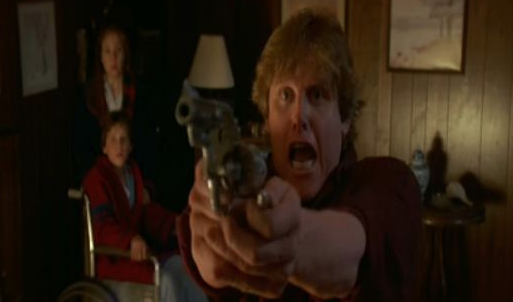
Takeaway points:
- I am not the person to make this analysis, but I’d love a critique of Silver Bullet regarding disability. I assume there’s a whole genre of disability criticism of horror, given the many times use of wheelchairs, blindness, and deafness play into horror plots. Marty uses a wheelchair, but the film doesn’t really use it – as many other films do – as an added element of danger. Marty never laments his paralysis to friends or family. He even jokes about it at the very end of the film. There is nothing holding Marty back, as his Uncle Red insists. Marty can retrieve his kite from a tree, sneak out at night to light fireworks. In fact, he proves more capable than nearly everyone else in town: he first injures the werewolf, and ultimately kills it. His motorized wheelchair is, in fact, instrumental in his escape from danger. Of course there are unfortunate asides – Tammy’s dad advocating for the death of all paraplegics, a weird scene in which Marty longingly watches the legs of baseball players – and they seem out of step with the rest of the film. Obviously, it would have been preferable to feature an actor who requires a wheelchair in the role, but, as I say, I’d be more interested in hearing what someone like the very smart disability in literature critic (and horror enthusiast), Angelo Muredda thinks of Silver Bullet.
- Silver Bullet is also of note because the werewolf doesn’t seem tormented by his transformation: the Reverend is fully aware he turns into a werewolf at night, and is just as dangerous as a human being. He claims he can’t kill himself (suicide is a sin), but surely there are other forms of werewolf restraint. (Also, I think God would smile more kindly on suicide than the murder of dozens of people.) During his bizarre monologue in the condemned bridge, the Reverend claims to be doing God’s work. He prevented Stella from killing herself. Who knows what sins Ernie or the various posse folk or the Sheriff committed, but I guess he was saving their souls, as well. Though over-the-top, Silver Bullet is a film about how often the church is not your deliverance from evil. It’s where the evil lives. The film depicts the idyllic Americana of good neighbours and decent people crumbling into alcoholic fathers, deadbeat dads, angry mobs, and duplicitous preachers. (Interestingly the film Spotlight begins with the cover-up of a priesthood molestation … in 1976.)
- The film is also an indictment of mob justice (or “private justice,” as its called here). Andy’s posse goes out half-cocked and several of them wind up dead or murdered in their wild thirst for vengeance. As the Sheriff grimly puts it to the Reverend, “This is that community spirit you’ve been talking about.” None of the mob are half as effective as two kids and their drunk uncle. And, tellingly, our heroes first go to the police. Only when the Sheriff is killed do they take matters into their own hands, which the film seems to suggest is the “correct” order of things. (Apparently the filmmakers have a lot more faith in the institution of law then they do the church.)
- I have to imagine that the eye patch-wearing Reverend Lowe was a visual influence on Garth Ennis and Steve Dillon’s popular comic character, Preacher. (Even if the comic preacher never turned into a werewolf.)
Truly terrifying or truly terrible?: Silver Bullet treads that line: it’s mostly terrible, but also too entertaining to truly dislike. The film isn’t scary – the embarrassing werewolf suit doesn’t help – though it’s surprisingly gory, given the otherwise kid-friendly story (kind of like Monster Squad, but moreso).
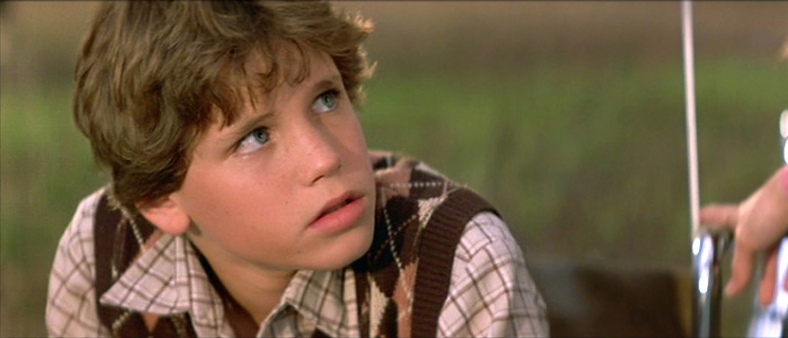
Best outfit: The argyle sweater vest that Marty wears when he confesses to Janey about the werewolf.
Best line: “You gonna’ make lemonade in your pants?” – one of the vigilantes, to her husband, during a scare moment
Best kill: The opening scene where a man’s head is torn clean off by one powerful swipe of a werewolf’s paw is really hard to top. (Luckily, the werewolf was pulling his punches when he fought with Red.)
Unexpected cameo: Reverend Lowe is Everett McGill, who I only knew as Big Ed (from Twin Peaks) prior. It was also nice seeing the dad from Life Goes On, Bill Smitrovich kicking around.
Unexpected lesson learned: While it may be tempting to store your ceramic pots in an outdoor shed, it does leave them susceptible to werewolf damage.
Most suitable band name derived from the movie: Since there’s already a Silver Bullet Band, let’s go with Skirmish Line.
Next up: The Legend of the Seven Golden Vampires (1974).
